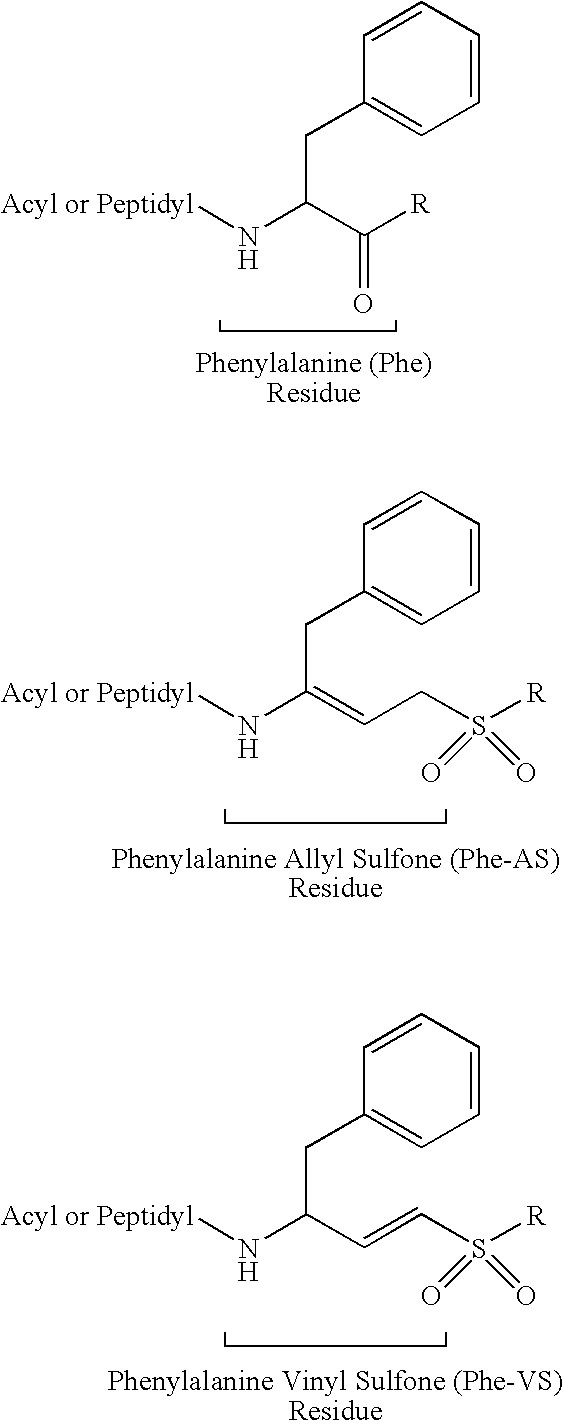Peptidyl allyl sulfones
a technology of allyl sulfone and peptide, which is applied in the direction of peptides, dipeptide ingredients, drug compositions, etc., can solve the problems of high cost, high cost, and high resistance of current drug therapies, and urgently need for new medicinal agents
- Summary
- Abstract
- Description
- Claims
- Application Information
AI Technical Summary
Benefits of technology
Problems solved by technology
Method used
Image
Examples
example 1
[0150]Diethyl Phenylsulfonylmethanephosphonate (PhSO2CH2PO(OEt)2). A mixture of chloromethyl phenyl sulfide (3.2 g, 20 mmole) and triethyl phosphite (3.3 g, 20 mmole) was heated at 130-140° C. for 5 h. The resultant mixture was distilled under reduced pressure, and the starting materials were distilled out. The oily residue was diethyl phenylmercaptomethanephosphonate, yield 3.4 g (65%). 1H-NMR (CDCl3) δ 1.2-1.3 (t, 6H, 2×CH3), 3.1-3.2 (d, 2H, S—CH2), 4.0-4.2 (m, 4H, 2×CH2), 7.2-7.4 (m, 5H, Ph). Diethyl phenylsulfonylmethanephosphonate was prepared by oxidation of diethyl phenylmercaptomethanephosphonate with potassium permanganate, yield 55%. 1H-NMR (CDCl3) δ 1.2-1.3 (t, 6H, 2×CH3), 3.7-3.8 (d, 2H, SO2—CH2), 4.1-4.2 (m, 4H, 2×CH2), 7.5-7.7 (m, 3H, Ph), 7.9-8.0 (d, 2H, Ph). MS m / z 293 (M+1).
example 2
2-(tert-Butoxycarbonylamino)-3-phenylpropionaldehyde (Boc-Phe-H).
General Procedure for the Mixed Anhydride Coupling.
[0151]N-Methylmorpholine was added to Boc-AA-OH or Cbz-AA-OH in CH2Cl2 at −15° C. followed by isobutyl chloroformate. N-Methylmorpholine was added to a cooled solution (−15° C.) of HCl.H-AA-VS-Ph or N,O dimethylhydroxylamine hydrochloride in CH2Cl2. This solution was added to the Boc-AA-OH or Cbz-AA-OH mixture, which had been stirring at −15° C. The mixture was continued to stir at −15° C. for 30 minutes, then warmed to room temperature and continued to stir over night. The amount of solvent was doubled, then washed with citric acid (10%, 3×), saturated NaHCO3 (3×), and brine (3×), and finally dried (MgSO4). The solvent was evaporated.
[0152]Boc-Phe-N(OCH3)CH3 was prepared from Boc-Phe-OH and N,O-dimethylhydroxylamine hydrochloride using standard mixed anhydride coupling procedure, yield 93%. 1H-NMR (CDCl3) δ 1.4 (s, 9H, Boc), 2.8-2.9 (m, 1H, CH2-Phe), 3.0-3.1 (m, 1H, C...
example 3a
[0153]Phenyl-(3S)-3-amino-4-phenylbut-1-enyl Sulfone Hydrochloride (Phe-VS-Ph.HCl). Boc-Phe-VS-Ph was prepared by reaction of Boc-Phe-H with diethyl phenylsulfonylmethanephosphonate in the presence of 2 N sodium methoxide, yield 85%. 1H-NMR (CDCl3) δ 1.3-1.4 (s, 9H, Boc), 2.9 (d, 2H, CH2-Phe), 4.4-4.5 (b, 1H, α-H), 4.6-4.7 (b, 1H, NH), 6.3 (d, 1H, CH═), 6.9-7.0 (dd, 1H, CH═), 7.1-7.3 (m, 5H, Ph), 7.5-7.8 (m, 5H, SO2-Ph). MS (FAB+) m / z 388 (M+1, 15%), 288 (M−Boc+1, 100%). Boc-Phe-VS-Ph was deblocked with 6.7 N HCl in EtOAc to give Phe-VS-Ph.HCl, yield 88%. 1H-NMR (DMSO-d6) δ 2.9-3.0 (m, 1H, CH2-Phe), 3.1-3.2 (m, 1H, CH2-Phe), 4.2 (b, 1H, α-H), 6.7-6.8 (m, 2H, CH═), 7.1-7.3 (m, 6H, CH═ and Ph), 7.6-7.8 (m, 5H, SO2-Ph), 8.6-8.8 (b, 2H, NH2). MS (FAB+) m / z 288 (M−Cl, 100%).
PUM
| Property | Measurement | Unit |
|---|---|---|
| temperature | aaaaa | aaaaa |
| concentration | aaaaa | aaaaa |
| pH | aaaaa | aaaaa |
Abstract
Description
Claims
Application Information
 Login to View More
Login to View More - R&D
- Intellectual Property
- Life Sciences
- Materials
- Tech Scout
- Unparalleled Data Quality
- Higher Quality Content
- 60% Fewer Hallucinations
Browse by: Latest US Patents, China's latest patents, Technical Efficacy Thesaurus, Application Domain, Technology Topic, Popular Technical Reports.
© 2025 PatSnap. All rights reserved.Legal|Privacy policy|Modern Slavery Act Transparency Statement|Sitemap|About US| Contact US: help@patsnap.com



